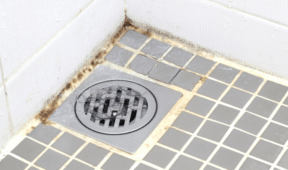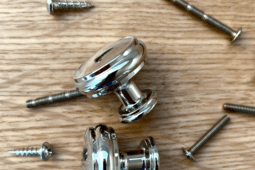The DIY Tailor: How to Hem Jeans Like a Pro

There are two basic principles to the ManMade approach to style and dress: fit is everything, and buy high-quality, universal items that will last. In order to help you hold on to those investment items, and make sure they suit you as best they can, ManMade is happy to present our latest series: The DIY Tailor. This summer and fall, professional tailor and alteration specialist Danni Trester will teach us some basic sewing principles and easy DIY repairs that every guy should know.
It's pretty sucky when a pair of your favorite jeans gets ruined because they're too long and you're stepping all over them. So what? So, there's a fix. Not only does hemming your jeans prolong the life span of your clothes, but you look less like a college sophomore circa 1998.
1) Supplies: you're going to need a couple of tools for this project. Basic items include a ruler, scissors, tailor's chalk, and thread. Some bigger things: iron, ironing board, and sewing machine.

If you're wondering what tailor's chalk is, it's a marking tool used by all sorts of professions. It's either a waxy or chalk rectangle that is used to temporarily mark on fabric. The waxy kind disappears when you steam or iron the fabric, the chalky kind disappears if you rub it or wash the garment. You can get it at fabric stores in the sewing or quilting notions area.

2) Once you've got all your supplies, you want to mark the jeans so you know where to shorten them. It's easier to do this part if you have someone to help. Try on your jeans and wear the shoes you would most likely wear with them. If you wear a couple of different pairs of shoes, put on the lowest ones.

3) Turn the excess fabric under until the pants are the length you'd like.

4) Mark on the back the leg using your tailor's chalk where you'd like the length.

5) Use your ruler and measure up from the floor where this mark is.

6) Roll up the other leg and transfer this measurement. This is called checking for a leg difference. Most people have one leg longer than the other, based on how you stand, the way you're built, or if you've had any surgeries/breaks. So if you measure the same distance from the floor for both legs, they'll hang the same.

Now both legs are marked!

7) Line up the side seams and lay out your jeans on a table or flat surface.

8) Make your chalk marks a little bigger/darker so they're easier to see.
9) Line up the marks and lay the legs one on top of the other.

10) Lay your ruler so the chalk mark is on the ruler's right side. 
11) Hold the ruler firmly down and run the chalk along the ruler with your right hand making a solid line across the pant leg.

12) Keep your left hand holding the ruler down, and use your right hand to flip over the top leg. Run your chalk along the ruler marking the backside of the top leg, and the top side of the bottom leg. 
13) Again, keep hold with your left hand, and flip over the bottom leg to mark the back.
14) When you're done, you should have a solid line all around both legs. 
15) The solid line you just made is where your finished hem will be. Now you need to mark extra fabric that you'll roll up to make the hem. The second line will be a fold line, and the third line is where you'll cut the excess off. Most jeans have a 1/2 inch rolled hem. But if you like a deeper hem, you can make it up to an inch on a pair of jeans. Men's jeans usually don't have anything wider than that, but if you're feeling fancy, go for it. But for this example, we're doing the traditional 1/2 inch.
16) One you've measured for your other lines, mark 'em up!

When you're done, it should look like this:

17) Cut off at the bottom line.



If you look at the pants from the front, the lines should be straight across.

18) Now you're ready to start sewing! Set up your machine with thread. For this demo, I'm using a heavy weight jean thread. Depending on your machine, you might have to use a lighter weight. If that's the case, just find a gold thread that's pretty close to the color thread that's on the rest of the pants. Once you've got your thread set up, practice sewing on your scraps so you can get the thread tension and stitch length correct.

19) When you are ready to start on the real deal, start on the inseam. Roll the fabric once to the fold line, and again to the hem line. Place the fabric under the foot and sink your needle. You may have to hand turn the wheel on the side of the machine a few stitches over this thickness.

20) Once you're over the hump, continue sewing and rolling, following your chalk marks. Use the measurement marks on the sewing machine to help you keep a straight line.

One thing you want to keep in mind as you're working is to line up your side seams. While you're sewing, the fabric on top has a tendency to work towards you. If you don't line it up, the hem can get twisted. Some denim companies do this on purpose, like Raleigh denim. But traditionally the seams should line up.

21) Keep going around, line up those seams!

As you come around to where you started, sew over the same stitching to make a continuous line. Again, you may have to turn the machine's wheel to slowly get over the thickness.

22) Once you've gone all the way around, snip your threads off and sew up the other leg!
23) Now it's time to press! Set the iron to a steam setting, heat alone won't do as good of a job. Press around the inside of the hem flattening the fabric.
Steam!
24) You can also press the outside a little if there is still chalk visible.
You did it!

Danni Trester is a tailor with over 11 years experience. She is currently located in Rochester, MN. In addition to alterations, she is a designer and shoemaker.









